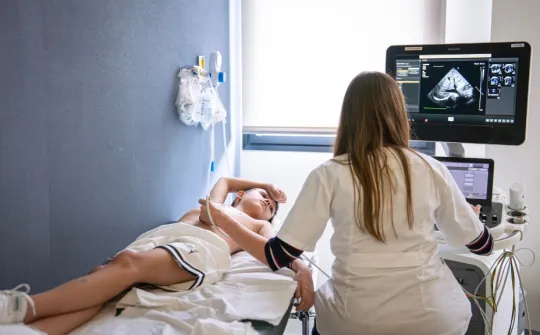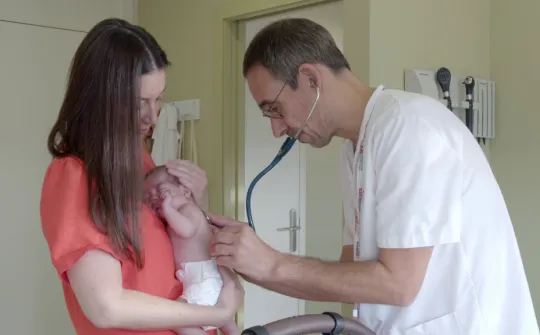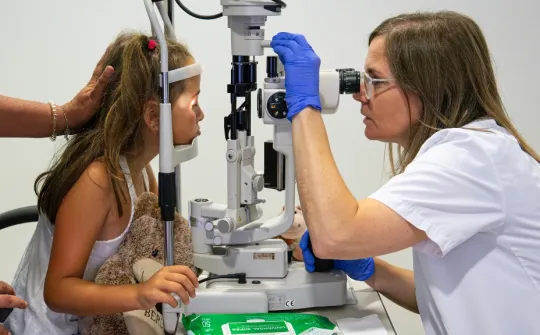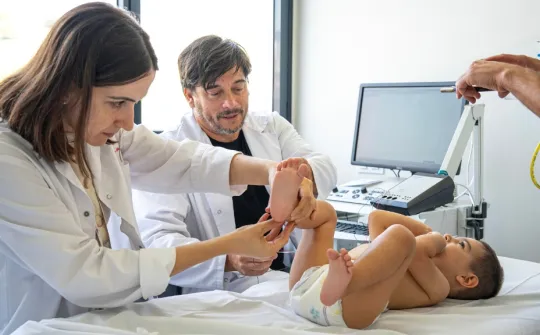Half of the surgeries performed at SJD Barcelona Children's Hospital are highly complex thanks to its "smart" surgical wing
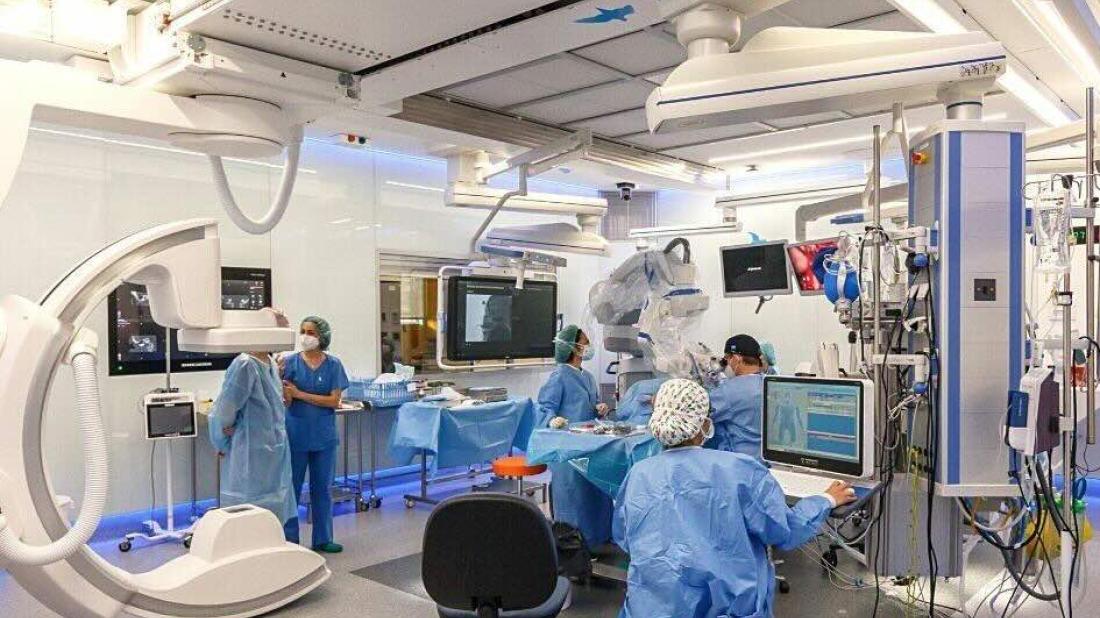
Two years after opening, the assessment highlights the change in the care model of the operating theatres.
In early 2020, SJD Barcelona Children's Hospital opened Spain's first paediatric operating theatres equipped with a magnetic resonance imaging system, a portable computed tomography (CT) scanner and a hybrid arch all in one operating space. The surgical wing covers 2,200 m² — more than double the previous area. It has eight operating theatres equipped with the most advanced technology, a 10-bed recovery room and an adjoining sterilisation centre.
Two years on, the teams' assessment of the running of the operating space is very positive, which has made the experiences of patients and their families more comfortable. The space has also improved working conditions for professionals, as they now work with the latest intraoperative technologies that are more extensive, automated and convenient than before.
The strategic goals established and achieved within two years of opening were to offer information to families in real time on the patient's status, to incorporate intraoperative imaging into the surgical process and to integrate technology and new professional positions with a view to improving healthcare quality, safety and outcomes. All of these goals have been met thanks to the efforts made in terms of resources, processes and coordination by many areas of the hospital. This infrastructure, which was implemented with support from the government and civil society, is currently operating at full capacity and is enabling the use of new surgical techniques.
The operating theatres are consolidated as a benchmark in paediatric surgery
Before inaugurating the new surgical wing, which was launched in a record six-month period, a comprehensive investigation was undertaken to determine each speciality's particular needs and offer them the most suitable equipment. This initial analysis phase proved key to acquiring the technology best suited to healthcare needs. Núria Palau, the head nurse of the surgical wing, stressed that putting this infrastructure in place was a major challenge since it entailed changes in working tools and protocols.
The use of advanced technological equipment mandated a major operational shift that involved adjusting working protocols, updating pathways, redesigning processes and reviewing and improving procedure safety. The healthcare teams made a major effort to implement all these changes while continuing to perform their routine surgical activities. The safety checks that patients go through before arriving in the operating theatre are now more effective. In addition, the new sterilisation centre (that adjoins the operating theatres) enables monitoring and traceability of all surgical materials that are highly rigorous and perfectly suited to the complexity of the procedures. All these things help improve the safety and performance of the operating theatres.
"The launch of the new children's surgical wing constitutes a substantial improvement in the space and the tools for performing surgical procedures", said Xavier Tarrado, head of the Pediatric Surgery Department. In this regard, the wing represents a qualitative leap forward in ergonomics, incorporation of intraoperative diagnostic technology and improvements in technology for minimally invasive surgery. All this translates to working with greater precision and more safety, resulting in improvements in the efficiency of the entire surgical process".
According to Osmeli Navarro, head of the Surgical area in Nursing Management, "the entire medical and healthcare team put in a great deal of hard work so that the project could move forward unimpeded, especially considering that they did so during the pandemic".
The addition of the hospital's new surgical wing has, without a doubt, led to the use of much more effective and safe working procedures, which enables the medical and healthcare team to perform more complex procedures. In fact, according to Juan José Lázaro, head of the Surgical area and children's Anaesthesiology Department, since the surgical wing opened, highly complex cases seen at the hospital account for nearly 50% of all surgeries performed.
In 2021, 5,737 interventions were performed in the Central Surgical Block, a third of the total number of surgeries that were carried out in the hospital as a whole: 15,374 (if we add the Area of Exploratory Techniques, the Ambulatory Surgery Unit or the hemodynamic facilities) .
Day-to-day use of intraoperative technology in the operating theatres
One of the operating theatres is specially designed for neurosurgery procedures and has a magnetic resonance imaging (MRI) system connected to the operating theatre that allows this type of test to be performed during or after the procedure, without taking the patient out of the surgical area. This is used to check, for example, that no traces of tumour have been left behind or that a thermal laser ablation procedure for epilepsy went smoothly. This negates the need for further procedures because initial results are provided during surgery. José Hinojosa, head of the Neurosurgery Department, directly links highly complex procedures to the use of this type of technology.
For heart surgery, two major tools are at the team's disposal: an extracorporeal pump for low-birth-weight and premature patients, and an image integration system that enables 3D visualisation of the heart and great vessels through the oesophagus. According to José María Caffarena, director of the Heart Area, "the new smart operating theatre for children's heart surgery places us at the forefront of highly qualified surgery, and represents added value that bolsters the quality of our outcomes and allows for better knowledge transmission".
Another of the eight operating theatres was specifically conceived for trauma procedures and features a hybrid arch, which is useful for professionals who perform surgery for scoliosis, a relatively common procedure at SJD Barcelona Children's Hospital. The hybrid arch shows in real-time where the screws that fix the back are placed, thereby contributing to the success of the procedure and reducing postoperative complications.
The equipment is supported by a CT scanner that can be moved to any operating theatre and is especially useful in procedures that require high precision, such as surgeries in growth areas and bone tumour removal surgery.
As César García Fontecha, head of the Orthopaedics and Traumatology Department, puts it, optimising space in operating theatres is very important and has allowed for more effective distribution of human and material resources. Fontecha also highlights the contributions of new technical devices, which have marked a before and after in terms of highly complex surgical procedures, which are increasingly common.
As well as the advances represented by intraoperative imaging, the operating theatres are also equipped with state-of-the-art anaesthesia stations that enable comprehensive monitoring of the patient's status throughout the surgical procedure.
Operating theatres designed to improve the experience of patients and professionals
The surgical wing was specially developed to make the experience of patients and their families as pleasant as possible, as parents may accompany their children at all times, both when they enter the operating theatre during the initial anaesthesia phase and in the area where patients wake up, in the post-anaesthesia care unit (PACU). In addition, through a mobile app that geolocates a band worn by the child, families know exactly where their child is in the process, significantly reducing anxiety.
The operating theatres were also designed with the paediatric patient in mind, as they are friendly environments with screens offering a useful distraction. The well-being of professionals, who have to work long hours in enclosed spaces with no connection to the outside world, was also very much taken into consideration. The new operating theatres at the hospital were designed to let light in, with windows and skylights, so that both professionals and families feel more comfortable and to improve working conditions. According to Oliver Haag, the head of the Otorhinolaryngology Department, now they can work comfortably and the digitalisation of the entire wing has freed up a great deal of time previously spent on manual procedures.
The role of bioengineering in the new surgical wing
Along with the inauguration of the new smart operating theatres, a new professional position, the bioengineer, has been added to the project. This new role is cross-cutting and facilities the daily work of the healthcare staff, given that, as noted by Xavier Escayola, head of Bioengineering, the medical team should concentrate solely on caring for the patient, not on investing time and resources in the technical aspects of the operating theatre. The goal of this new position is to bring value by leveraging knowledge of technology and the sector to detect possible improvements, and implementing projects that can make these improvements a reality. Finally, the team is also in charge of seeking out increasing numbers of technological partners for the hospital to maintain its standing as a leading international centre.
In this regard, Josep Rubio, head of the Maxillofacial Surgery Unit, explains that the new operating theatres have screens and cameras that make it possible to record procedures and hold specialised training courses. In addition, the new CT scanner and intraoperative hybrid arch boost the safety and quality of procedures planned in advance with 3D, such as jaw surgery, since the report in real-time the percentage accuracy of the procedure compared to what had been planned.
Future challenges
The main future challenge lies in incorporating robotics into these operating theatres. The model to be used at SJD Barcelona Children's Hospital involves collaborative robots, which can be controlled from anywhere through a 5G connection. These types of robots, which work in collaboration with professionals, could offer advantages in terms of increased safety and scheduling of surgeries. This existing technology must be adapted to paediatric patients, whose size and needs in the surgical setting are very different from adults. Another challenge, currently in the implementation phase, is the use of 3D augmented reality, which enables the medical team to see the patient's hidden anatomy. The goal is for this same system to intelligently prevent risk during surgeries.
SJD Barcelona Children's Hospital is currently seeing the culmination of a period of transition — this surgical wing being just the tip of the iceberg — without losing sight of the human side of this major project. According to Francesc García Cuyàs, a Medical Management associate, "without great teamwork and collaborative efforts among all technical and healthcare professionals, this major project would not have been possible".
The construction of the new operating theatres required an investment of nearly €20 million to cover the building costs and equipment. The project was funded by the Catalan Health Service (CatSalut) and contributions from the Fundació Privada Daniel Bravo Andreu, the Fundació Nou Mil·lenni, the Asociación Benéfica Anita, the Fundació Barberà Bardés, the Fundació Creatia and Mindray, among others.In the process of building, fitting out and launching the surgical wing, SJD Barcelona Children's Hospital also benefited from technological support and advice from Philips.
